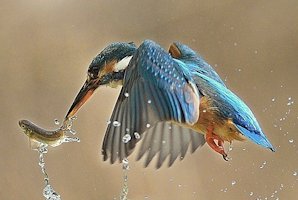
|
Hovering Flight of Birds
In hovering flight, a bird generates its own lift by means of rapid wingbeats. Holding its body nearly vertical, with its wings firmly flexed at the elbow joint, a hovering bird moves its wing surfaces forward and back in a horizontal plane; each of the two phases of the stroke generates lift. The blur of a hovering bird's wing beating the air like propellers is a sharp contrast to its body, which appears to be suspended. Hummingbirds have been known to fly up to speeds of 60 miles per hour in a tail wind.s No bird of prey even attempt to catch a hummingbird in flight. Shallow rapid wingbeats in a forward-backward motion characterize the flight of this Belted Kingfisher as it hovers over a small stream. Click for Hovering Flight Diagram |
|
Kestrels and kingfishers perform amazing maneuvers, hovering over land and sea. But as impressive as the hovering of a kestrel or kingfisher may be, these birds are mere dabblers in this particular talent. It is only in hummingbirds that nature has structured the wings in such a way that when in motion they act like a perfect lifting rotor. Their pointed wings do not flap and glide as other bird wings do, but propel them through the air by moving up and down, up and down, at a furious rate of 70 times a second. After feeding at a flower they can fly backward, climb vertically, tun at lightening speed, and come to a sudden standstill in midair. The human eye is incapable of deciphering exactly how a hummingbird wings beat, because they move so quickly, but slow-motion photography has unveiled the secret: Viewed from the side, the hummingbird beats it wings back and forth in a horizontal figure eight, producing lift on both the forward and backward strokes. Energy consumption during the whirring flight of the hummingbird is, understandably, enormous. The pectoralis minor muscle used for raising the wing is as much as 50 percent heavier than the pectoralis major, which in most birds is 10 to 20 times heavier than its counterpart. Hummingbirds consume 8 to 12 times as much oxygen as other small birds, and the heart and respiratory systems are proportionately 3 times as large as, for example, those of a pigeon. |
|